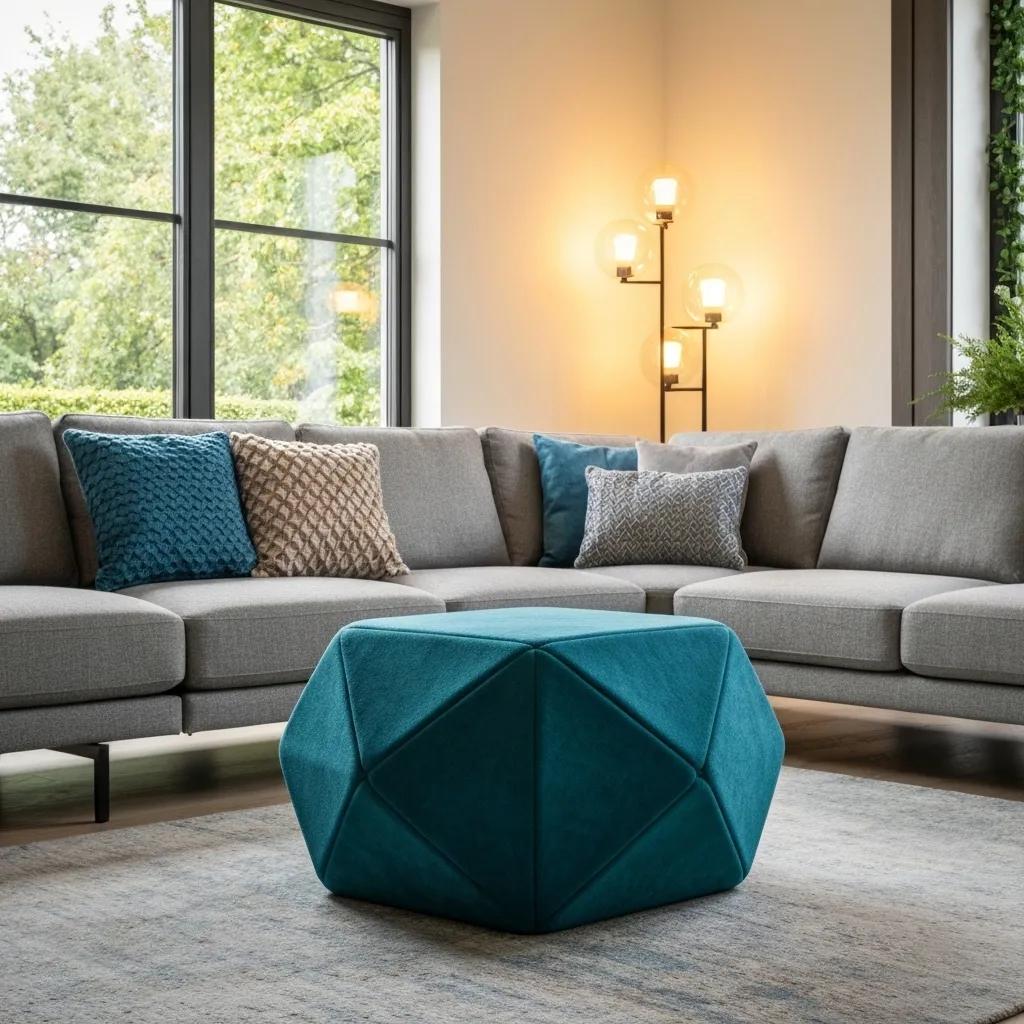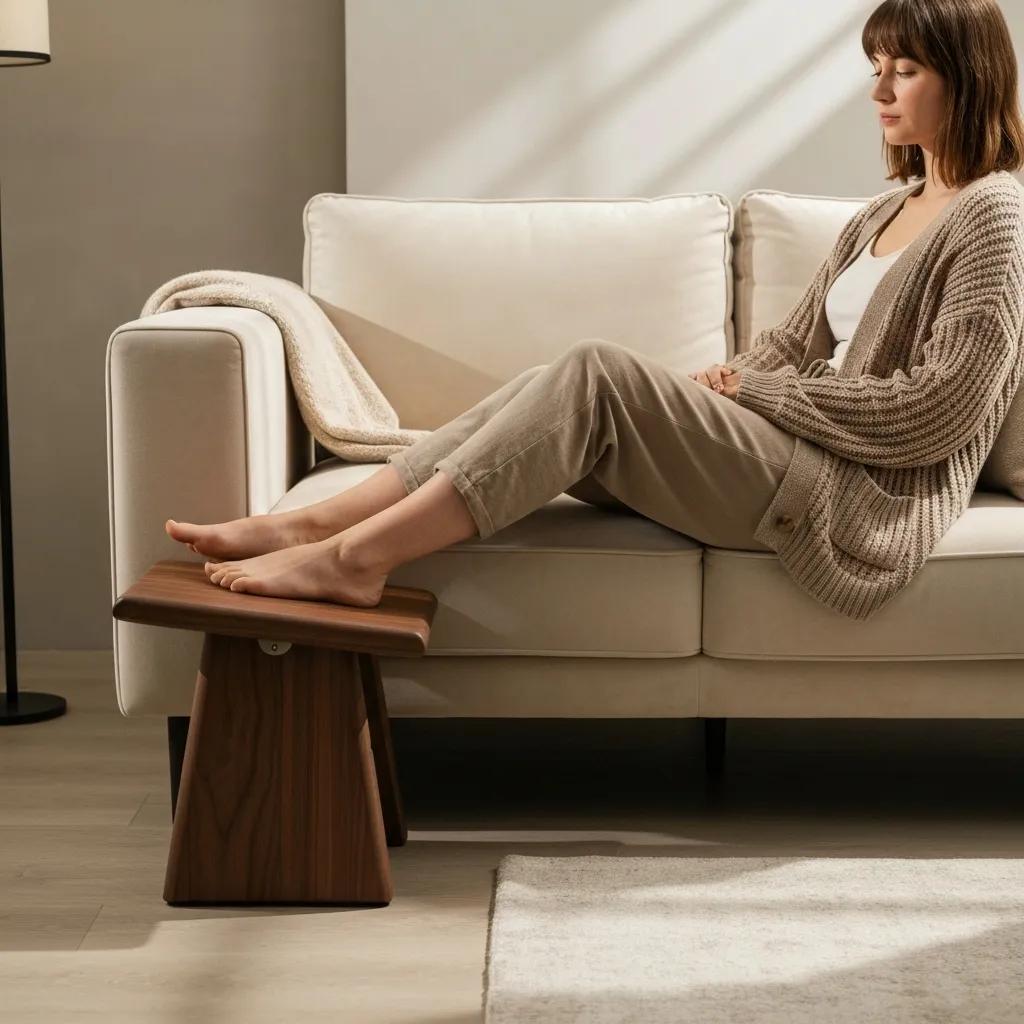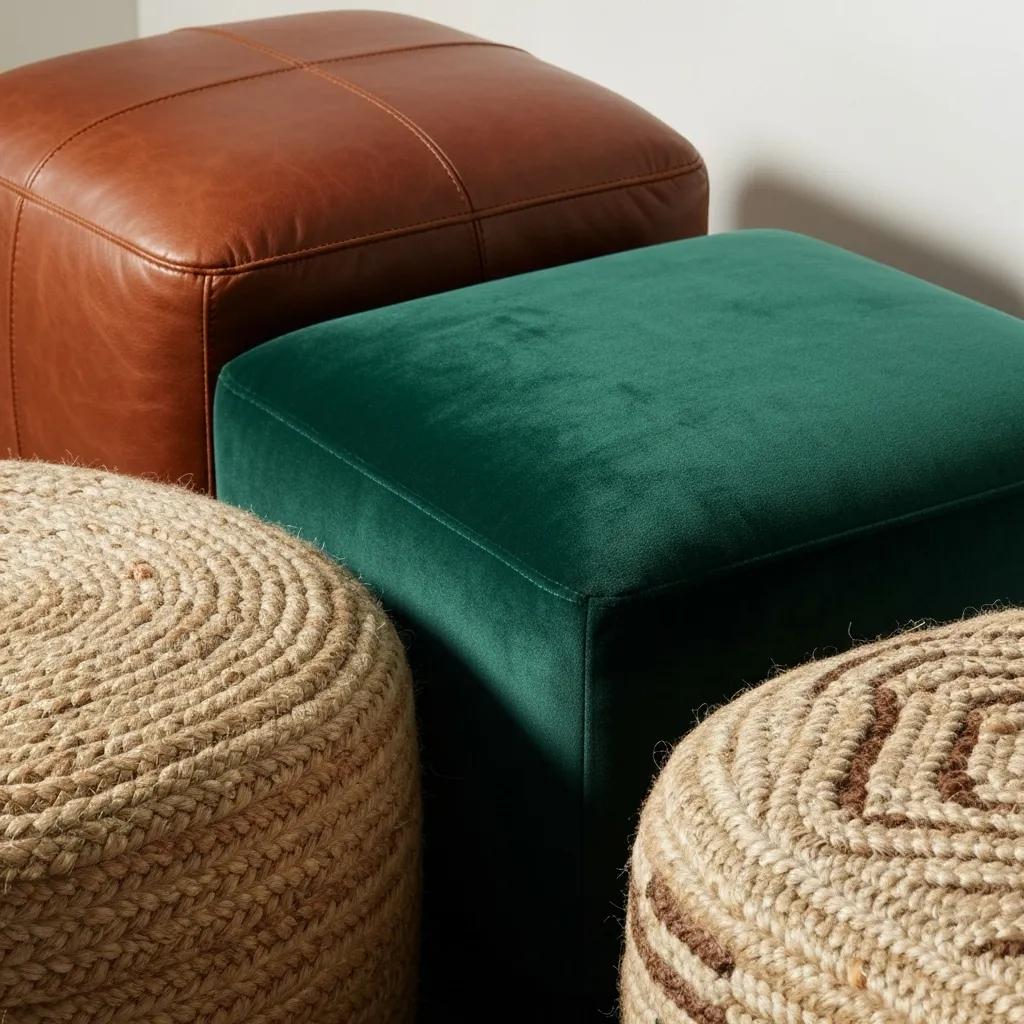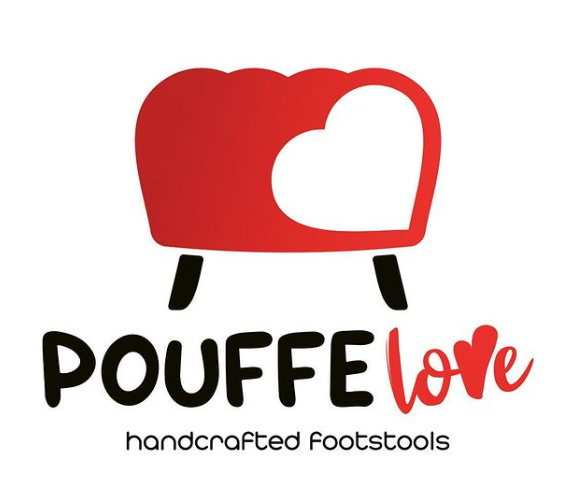
How to Choose Your Perfect Footstool: The Ultimate Guide to Size, Material, and Style
Selecting the right footstool can transform your living space by enhancing comfort, improving posture, and elevating decor. Yet measurement missteps often lead to awkward proportions, cramped layouts, and wasted investment. In this guide, you’ll discover how to determine the ideal footstool height, choose the perfect size for your room, evaluate materials for durability and style, select a functional type, integrate seamless styling, balance budget constraints, and master accurate measurement techniques. By the end, you’ll have all the measurement insights and design strategies needed to find your perfect footstool.
What Is the Ideal Footstool Height for Comfort and Ergonomics?

Footstool height refers to the vertical distance from the floor to the top surface where you rest your feet. Matching this height to your seating ergonomics prevents strain in ankles, knees, and lower back. For example, a footstool around 35 cm aligns nicely under most sofas and armchairs to promote relaxed legs and healthy circulation. Understanding height fundamentals leads us to explore sofa-relative measurements next.
What Height Should a Footstool Be Compared to Your Sofa or Chair?
A footstool should be 1–2 cm lower than your sofa or chair seat height to provide natural leg support without over-extension. This slight difference ensures your knees remain slightly bent, reducing tension in your lower back. For instance, if your sofa seat is 40 cm high, choose a footstool around 38 cm. Balancing footstool height relative to seating fosters proper posture and grounds our discussion on circulation benefits.
How Does Footstool Height Affect Posture and Blood Circulation?
Proper footstool height aligns your ankles, knees, and hips in a neutral position, reducing pressure on joints and encouraging healthy blood flow. When your feet rest just below seat level, veins return blood more efficiently, minimizing swelling and fatigue.
Selecting a height that sits 2–3 cm below your seating surface delivers maximum ergonomic benefit and transitions smoothly to standard range guidelines.
Ergonomic Benefits of Footstools
Proper footstool height can significantly improve posture and blood circulation by aligning the ankles, knees, and hips in a neutral position. This alignment reduces pressure on joints and promotes healthy blood flow, minimizing swelling and fatigue. A footstool that is 2–3 cm lower than the seating surface delivers the most ergonomic benefits.
This research supports the article’s claims about the importance of footstool height for health and well-being.
What Are the Standard Footstool Height Ranges for Different Uses?
Different activities call for different footstool heights:
- Living Room Relaxation – 30–40 cm supports casual lounging under sofas.
- Office Ergonomics – 40–45 cm fits under desk chairs for proper leg elevation while working.
- Gaming or Reading – 30–40 cm offers low seating comfort on the floor or floor-level chairs.
Understanding these typical ranges ensures you choose a footstool height that matches each use case before exploring spatial fit.
How Do You Choose the Right Footstool Size for Your Space?
Footstool size encompasses width and depth, determining how it fits within a room’s floorplan. A well-sized footstool maintains clear walkways, complements seating configurations, and avoids visual clutter. By matching dimensions to room scale, you achieve smooth traffic flow and balanced aesthetics, which leads to examining size recommendations by room category.
What Footstool Sizes Work Best for Small, Medium, and Large Rooms?
Adhering to these ranges prevents cramped layouts and sets up our exploration of shape effects.
How Do Footstool Shapes Impact Room Layout and Functionality?
Footstool shape influences flow and usage patterns.
- A square footstool provides straight-edge alignment with sofas and sectional corners.
- A round footstool encourages softer traffic patterns and acts as an informal table.
- A rectangular footstool extends parallel to seating, ideal for modular arrangements.
Selecting a shape aligned with your room’s geometry enhances both circulation and versatility before considering placement distance.
What Is the Optimal Distance Between Footstool and Sofa?
Maintaining a 30–45 cm gap between footstool and sofa ensures leg movement freedom and easy walk-through space. This distance allows your feet to rest naturally without forcing you to lean forward or stretch back, supporting comfort and traffic flow into adjacent areas.
Which Footstool Materials Offer the Best Durability and Style?

Footstool materials determine appearance, lifespan, and care requirements. Leather delivers classic elegance and robust wear resistance, fabrics introduce color and texture versatility, and sustainable options satisfy eco-conscious design. Aligning material attributes with your lifestyle bridges style preferences and maintenance routines before diving into specific pros and cons.
What Are the Pros and Cons of Leather and Faux Leather Footstools?
How Do Fabric Options Like Velvet, Cotton, and Linen Compare?
Common upholstery fabrics offer distinct benefits:
- Velvet provides a plush, luxurious feel ideal for formal settings.
- Cotton blends are breathable, comfortable for year-round use.
- Linen delivers a natural, textured look with moderate durability.
Matching fabric comfort and appearance to your decor ensures harmonious integration prior to exploring eco-friendly choices.
What Sustainable and Eco-Friendly Materials Are Available for Footstools?
Environmentally conscious materials include:
- Reclaimed wood frames paired with certified organic fabrics
- Recycled PET fiber upholstery for stain resistance
- Bamboo rattan structures offering lightweight strength
Choosing sustainable components supports both planetary health and design innovation before moving on to maintenance strategies.
How Should You Maintain Different Footstool Materials for Longevity?
Consistent upkeep protects material beauty and extends service life, paving the way to consider functional footstool types.
Material Durability and Maintenance
The choice of footstool material impacts its durability, appearance, and required care. Leather offers high wear resistance and classic elegance, while fabric options like velvet, cotton, and linen provide different textures and styles. Proper maintenance, such as regular cleaning and conditioning, is essential to extend the lifespan of the chosen material.
This citation reinforces the article’s discussion on the importance of material selection and maintenance for footstool longevity.
What Types of Footstools Best Suit Your Functional Needs?
Footstool functionality spans from simple footrests to multifunctional storage units and extra seating solutions. Identifying the primary use—whether elevating feet, organizing clutter, or supplementing seating—ensures you select a design that maximizes utility. With purpose defined, you can evaluate specific type advantages starting with storage models.
How Does a Footstool with Storage Maximize Space and Organization?
A storage footstool conceals blankets, magazines, or remote controls under its padded lid, reducing visible clutter and freeing floor space. This dual-purpose design merges comfort and organization, making it ideal for rooms where surface space is limited and transitions naturally into a comparison of common footstool variations.
What Are the Differences Between Ottomans, Pouffes, and Footstools?
Can a Footstool Serve as Extra Seating or a Coffee Table Alternative?
Yes, many footstools double as occasional seating or can hold a tray for drinks and snacks. A firm cushion and stable frame transform it into a practical seat, while adding a decorative tray creates an impromptu coffee table that adapts to guest needs without permanent commitment.
What Are the Health Benefits of Using an Ergonomic Footstool?
Using a correctly sized ergonomic footstool can:
- Improve lower-limb circulation by reducing venous pressure
- Alleviate lumbar strain through balanced leg elevation
- Promote healthy spine alignment by keeping knees slightly lower than hips
These wellness advantages underscore the importance of precise height and size selection as you move into styling considerations.
How Can You Style Your Footstool to Match Your Home Decor?
A footstool’s style integrates color, pattern, and form to complement or contrast your existing furnishings. Choosing upholstery and accents that echo room motifs creates visual harmony, while deliberate contrast can introduce focal interest. With styling fundamentals covered, we’ll examine matching strategies next.
Should You Match or Contrast Your Footstool with Your Sofa?
Both approaches work. Matching upholstery unifies a cohesive look, especially in minimalist or Scandinavian interiors. Contrasting colors or textures—such as a velvet footstool against a cotton sofa—injects personality and creates design focal points that enliven neutral palettes.
What Are Creative Ways to Decorate a Footstool with Accessories?
Enhance your footstool by:
- Placing a decorative tray to hold candles or coasters
- Draping an accent throw for added texture and warmth
- Top-stitching patterned cushions for seasonal flair
These styling additions turn a simple footstool into a personalized decor element before exploring interior design alignments.
Which Footstool Styles Fit Different Interior Designs Like Modern or Rustic?
Aligning style features with your room’s overall concept ensures seamless integration and leads to room-specific selections.
How to Choose Footstools for Specific Rooms: Living Room, Bedroom, and Office?
- Living Room: Opt for versatile shapes and textures that coordinate with sofas and accent chairs.
- Bedroom: Select soft, low-profile footstools that complement bedding patterns and provide a cozy spot for putting on shoes.
- Office: Choose a compact, durable design that slides under your desk to support proper leg elevation during long work sessions.
Room-driven decisions ensure that each footstool fulfills both functional and aesthetic roles before budget considerations.
How Do Budget and Price Influence Your Footstool Choice?
Budget dictates how much you can invest in materials, craftsmanship, and multifunctional features. Understanding typical price ranges for various footstool types helps set realistic expectations and guides you toward the best value options. With cost brackets defined, you can balance expenditure against long-term durability and style.
What Are Typical Price Ranges for Different Footstool Types and Materials?
These brackets help you pinpoint affordable yet quality choices before refining purchase criteria.
How to Balance Cost with Durability and Style When Buying a Footstool?
- Prioritize high-wear materials like leather or tightly woven fabrics in high-traffic areas.
- Consider modular or DIY covers that refresh design without replacing the entire piece.
- Evaluate warranty terms and craftsmanship details to ensure long-term value.
Applying these guidelines leads naturally to mastering measurement and buying practices.
What Are the Best Practices for Measuring and Buying Your Footstool?
Accurate measurements and clear criteria prevent unwelcome surprises when you receive your footstool. By systematically documenting sofa height, room dimensions, and clearance requirements, you empower yourself to compare options confidently—whether online or in-store.
How to Measure Your Sofa and Room for the Perfect Footstool Fit?
- Measure sofa seat height from floor to top of cushion.
- Record sofa width and available floor space in front of seating.
- Map out surrounding furniture and walkway clearances.
These steps provide the key data points needed to narrow down appropriate dimensions.
What Tools and Tips Help Ensure Accurate Footstool Dimensions?
- Use a retractable steel tape measure for reliable linear measurements.
- Employ a laser distance finder for quick room-wide checks.
- Take notes or photos of measurement points to reference during shopping.
With precise data in hand, you can apply it directly to product specifications.
How to Use Measurement Data to Select the Right Footstool Online or In-Store?
Match your recorded sofa height and space dimensions to the footstool’s listed specifications. Filter product searches by height range and footprint, then verify clearance in product images or showroom setups. This process ensures that your chosen footstool will fit seamlessly into your seating arrangement and room layout.
Choosing a footstool becomes straightforward once you align height, size, material, function, style, budget, and measurement best practices. Measure carefully, weigh durability against design, and select the type that serves your needs. With these guidelines in hand, you’re ready to elevate both your feet and your home decor—one perfectly chosen footstool at a time.
